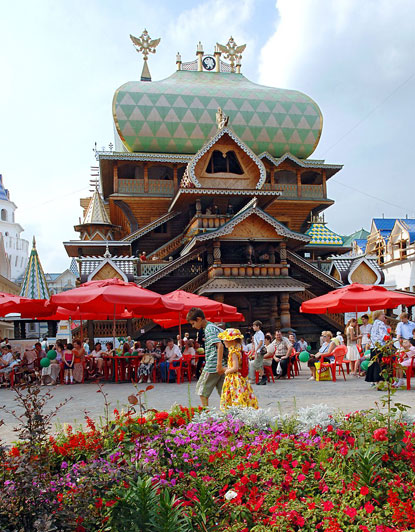| In Moscow, All the City's a Stage |
| Monday, 03 October 2011 05:10 | |||
|
Moscow opens its streets and squares to performers, artists and musicians over the next month to draw tourists and brighten the mood of locals.  Moscow. Red Square. One hour before midnight. A wind orchestra from the Italian town of Lecco is surrounded by a dense circle of spectators. The men in the orchestra wear hats decorated with huge black feathers, throw up their instruments and, to the crowd's delight, play another few songs by the metro entrance. The evening program of the Spasskaya Tower International Military Music Festival finished half an hour ago, but no one wants to go home yet. And at either end of Red Square you can still hear the sounds of bagpipes, trombones, drums and applause. The fourth Spasskaya Tower Festival in September featured more than 500 musicians from 15 countries. The festival included all kinds of military, folk and pop music, weapons demonstrations and parades, a laser show, bikers and pyrotechnics - on Red Square, lasting five days. Cannons were fired from the Spasskaya tower, giving the event a special sense of ceremony. The Cavalry Honor Escort of the President's Regiment, the Russian Horn Orchestra, the Presidential Orchestra all added to the event. The Jaguares de la Tamayo marching band and the Tenochtitlan Folk Dancing Company from Mexico infected everyone with their Southern optimism, and National Presidential Orchestra of Ukraine surprised the audience with their jazz numbers. Sergei Shpilko, chairman of the city's tourism committee, is convinced that a new culture and tourism project, a Medieval Festival "Times and Eras," which also debuted in Moscow this month, will become an annual fixture on the festival scene that "in time will become no less prestigious than, for example, the Venice Festival or the Brazilian Carnival."  Moscow Showcases International Art Certainly the Moscow Bienale of Contemporary Art, which draws many international artists and patrons since it began in 2005, is an example of how sophisticated Moscow festivals have become in recent years, finally competing with cities like Edinburgh and Venice. This year, the festival is titled "Rewriting Worlds" and includes 64 artists and 16 artistic groups from 33 countries. In 2005, the Bienale helped launch the career of Russian provocateurs Blue Noses, who opened the show with their installation, "Lenin Turning in his Grave." Russian artists remain a significant draw to the festival, and this year will include Olga Kisseleva and Igor Makarevich among many others. The Bienale opened Sept. 23 and closes Oct. 30. In the middle of the Bienale showcase, the traditionally grey Moscow autumn will be brightly lit in blazing colors, and the center of Moscow will turn into one big art installation. The director of the famous Fete des Lumieres in Lyon has been invited to set up the first International Festival of Light. The magnificent light show will be projected around 15 sights right in the city center, including Red Square, Bolshoi Theatre, Cathedral of Christ the Savior, Historical Museum and Manege Square. Tourists can also pick up souvenirs at the International Handcraft Fair at Izmailovo until Oct. 15. This fairy-tale, mostly outdoor exhibition space features Russian rural skills and arts, and includes creations of both independent craftsmen as well as businesses from Moscow and Russia's regions. The crafts range from birch baskets to fur hats. It all takes place in the romantic ambience of the colorful Izmailovsky Kremlin. More details about the Spasskaya Tower festival at Times and Eras" military-historical festival The first in a series of festivals dedicated to different periods in Russian history took place in Moscow's nearly 1,000-acre Kolomenskoye Park earlier this month. This year's "Times and Eras" event was dedicated to the 9th through the 11th centuries in Russia, and hosted guests from the United States, Germany, Sweden and many other countries. Spectators could visit a Slavic village, see a Viking landing from the Moscow River and dine in authentic taverns from the Middle Ages. In accordance with Russian customs of the time, the opening ceremony included a fist fight among the actors. The feedback from the first festival was very positive, except some rain dampened the costumes, though not the spirits. However, some craft vendors found linen tents to be poor protection from the rain. See photos, in Russian, at historyfest.ru.
|

